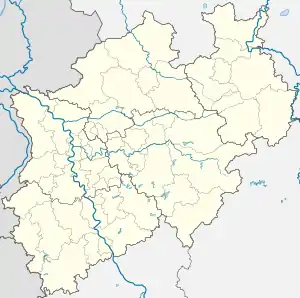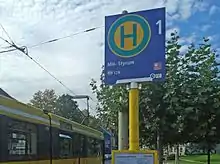Mülheim-Styrum station
Mülheim-Styrum station is located in the district of Styrum in the German city of Mülheim in the German state of North Rhine-Westphalia. It is on the Witten/Dortmund–Oberhausen/Duisburg line and is classified by Deutsche Bahn as a category 3 station.[1]
| Through station | ||||||||||||||||||||||||||||||||||||
_Styrum_2.jpg.webp) | ||||||||||||||||||||||||||||||||||||
| Location | Styrum, North Rhine-Westphalia Germany | |||||||||||||||||||||||||||||||||||
| Coordinates | 51°26′57″N 6°51′09″E | |||||||||||||||||||||||||||||||||||
| Owned by | Deutsche Bahn | |||||||||||||||||||||||||||||||||||
| Operated by | ||||||||||||||||||||||||||||||||||||
| Line(s) | ||||||||||||||||||||||||||||||||||||
| Platforms | 5 | |||||||||||||||||||||||||||||||||||
| Train operators | DB Regio NRW | |||||||||||||||||||||||||||||||||||
| Connections | S 1 S 3 | |||||||||||||||||||||||||||||||||||
| Other information | ||||||||||||||||||||||||||||||||||||
| Station code | 4221 | |||||||||||||||||||||||||||||||||||
| DS100 code | EMRY | |||||||||||||||||||||||||||||||||||
| Category | 3 [1] | |||||||||||||||||||||||||||||||||||
| Fare zone | VRR: 340[2] | |||||||||||||||||||||||||||||||||||
| Website | www.bahnhof.de | |||||||||||||||||||||||||||||||||||
| History | ||||||||||||||||||||||||||||||||||||
| Opened | 1880[3] | |||||||||||||||||||||||||||||||||||
| Services | ||||||||||||||||||||||||||||||||||||
| ||||||||||||||||||||||||||||||||||||

| ||||||||||||||||||||||||||||||||||||
| Location | ||||||||||||||||||||||||||||||||||||
 Mülheim-Styrum Location in North Rhine-Westphalia  Mülheim-Styrum Location in Germany  Mülheim-Styrum Location in Europe | ||||||||||||||||||||||||||||||||||||
Location and layout
-Styrum.JPG.webp)
The station is served by passenger and freight traffic. The track system comprises a total of five platform tracks. S-Bahn trains to and from Duisburg use tracks 2 and 5, the trains to and from Oberhausen use tracks 3 and 4 on the two island platforms. The house platform (platform 1) and track 6 (which has no platform) are used for long-distance and regional trains. Sidings 8–18 are to the north of this (although track 12 is vacant).
In the station there are two track connections to the Mannesmann tube factory and to the Friedrich Wilhelms steel works.
The station has been controlled from the Mülheim-Styrum signal box since 1967. In addition to Styrum station, it also controls Mülheim (Ruhr) West station, Mülheim Hauptbahnhof and the subsequent sections of open line. The signal box controls a relay interlocking of the SpDrS59 class, the remotely controlled interlocking at Mülheim Hauptbahnhof is of the SpDrS60 class. The open line to Essen is equipped with an automatic block signaling interlocking of class Sbk60.[4] The signal box was put out of operation until 21 March 2016 by a fire in the control room in the early morning of 4 October 2015.[5][6][7]
History
Styrum station was built on the Bergisch-Markisch Railway Company (Bergisch-Märkische Eisenbahn-Gesellschaft; BME) line from Ruhrort to Essen, which was opened in 1862. In addition to this, the connection curves from Oberhausen and Duisburg joined the line in the Styrum area. The connection from Kettwig, opened in 1876, provided another BME line connecting to the south. The latter line was initially used from Styrum only by freight traffic, but passenger trains ran directly to Mülheim station (mow Mülheim (Ruhr) West).
When Styrum was incorporated into Mülheim an der Ruhr, the station was renamed to Mülheim (Ruhr)-Styrum.[3] A new entrance building was opened in 1910 and after that passenger trains from Kettwig ran to Styrum.[8]
Services
-Styrum_01_S-Bahn.jpg.webp)


Mülheim (Ruhr)-Styrum station is only served by regional trains and Rhine-Ruhr S-Bahn trains. It is served by S-Bahn lines S 1 and S 3, providing direct connections to Düsseldorf, Duisburg, Oberhausen, Essen, Bochum and Dortmund. Lines RB 33 (Rhein-Niers-Bahn) and RE 49 (Wupper-Lippe-Express) provide connections to Aachen, Krefeld, Mönchengladbach, Wesel and Wuppertal. Until 1995, there was also a shuttle service operated with class 515 battery-powered cars to Duisburg-Ruhrort. The trains of the Lower Ruhr Valley Railway (Untere Ruhrtalbahn) ran from Kettwig to Styrum until 1968. The terminal track for the Kettwig trains and the reversing track for the battery powered railcars (located between tracks 3 and 4) no longer exist since the two services have been terminated.
Mülheim (Ruhr)-Styrum station is served by the following lines:
| Line | Route | Frequency |
|---|---|---|
| RE 49 Wupper-Lippe-Express |
Wesel – Oberhausen – Mülheim-Styrum – Mülheim – Essen – Wuppertal-Vohwinkel – Wuppertal | 60 mins |
| RB 33 Rhein-Niers-Bahn |
Essen – Mülheim – Mülheim-Styrum – Duisburg – Krefeld – Mönchengladbach – Aachen | 60 mins |
| S 1 | Dortmund – Bochum – Essen – Mülheim – Mülheim-Styrum – Duisburg – Düsseldorf Airport – Düsseldorf – Hilden – Solingen | 30 min |
| S 3 | Oberhausen – Mülheim-Styrum – Mülheim – Essen – Hattingen (Ruhr) Mitte | 30 min |
It is served by three bus routes, 122, 128 and 129, operated by Mülheimer VerkehrsGesellschaft.[9] Until 2015, it was also served by a tram line.
In freight transport, the handling of metal products, such as steel coil and steel plate, is particularly important.
References
- "Stationspreisliste 2021" [Station price list 2021] (PDF) (in German). DB Station&Service. 16 November 2020. Retrieved 3 December 2020.
- "Wabenplan für das Rheinbahn-Bedienungsgebiet" (PDF). Rheinbahn. 1 August 2008. Retrieved 4 November 2019.
- "Mülheim-Styrum operations". NRW Rail Archive (in German). André Joost. Retrieved 29 March 2020.
- Joost, André. "Mülheim (Ruhr)-Styrum Mf signal box". NRW Rail Archive (in German). André Joost. Retrieved 29 March 2020.
- "Brand in Mülheimer Stellwerk". WDR.de (in German). 5 October 2015. Archived from the original on 6 October 2015. Retrieved 29 March 2020.
- "Stellwerk-Brand: Bahn-Fahrplan bleibt bis März 2016 beeinträchtigt". Der Westen (in German). 1 March 2016. Retrieved 29 March 2020.
- "Das Stellwerk in Mülheim ist ab Mitte März wieder in Betrieb". Der Westen (in German). 1 March 2016. Retrieved 29 March 2020.
- Menke, Martin. "Die Geschichte der Ruhrtalbahn" (in German). Eisenbahnfreunde Mülheim e.V. Archived from the original on 7 July 2017. Retrieved 27 March 2020.
- "Mülheim-Styrum station". NRW Rail Archive (in German). André Joost. Retrieved 29 March 2020.